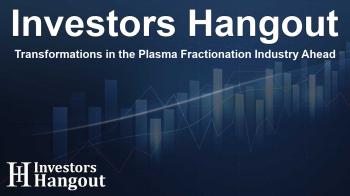Transformations in the Plasma Fractionation Industry Ahead

Rising Growth in the Plasma Fractionation Market
The global plasma fractionation market is on an impressive trajectory, currently valued at approximately USD 35.22 billion, with projections indicating it may reach USD 72.86 billion by the year 2034. This growth is driven by a compound annual growth rate (CAGR) of 7.54%, reflecting the rising demand for plasma-derived therapies across the healthcare landscape.
What is Plasma Fractionation?
Plasma fractionation refers to the important process of separating blood plasma into components like albumin, immunoglobulins, and clotting factors intended for therapeutic applications. A significant driver in this market is the increasing geriatric population and the growing prevalence of conditions requiring these therapies such as autoimmune diseases and hemophilia. Notably, advancements in fractionation technology are allowing leading companies to prioritize safety and purity through cutting-edge techniques, including chromatography and viral filtration.
Key Market Insights
- North America was the largest market player in 2024, largely due to its well-established plasma collection infrastructure and increasing demand for therapies to treat chronic and neurological disorders.
- Europe is expected to witness the fastest growth during the forecast period, attributable to significant innovations and investments in plasma fractionation technology.
- The immune globulin segment led the market in 2024, with a wide range of therapeutic applications, while the coagulation factor segment is anticipated to exhibit substantial growth going forward.
Significant Drivers in Market Growth
The increase in lifestyle-related diseases and a higher incidences of immunodeficiency disorders contribute tremendously to the market's growth. Furthermore, numerous pharmaceutical companies are expanding their plasma collection capabilities to meet rising global demands. The development of higher-concentration immunoglobulins and novel treatment formulations targeting infectious diseases also plays a crucial role in supporting market progression.
Current Trends and Innovations
- Recently, Biolab Holdings, Inc. entered a strategic partnership with Terraplasma Medical GmbH to innovate a portable cold atmospheric plasma device.
- GC Biopharma has signed an agreement with the Thai Red Cross Society to enhance workforce training aimed at advancing the manufacturing of plasma-derived medicinal products.
- Additionally, the collaboration between Kenox Pharmaceuticals and Lactiga US is focused on developing new mucosal-targeted therapies to enhance immunity in individuals suffering from immunodeficiencies.
Regional Market Dynamics
In 2024, North America captured the largest market revenue share due to robust investments in plasma collection operations and an effective treatment provision for chronic ailments. Initiatives such as the advanced AI algorithms employed in managing donor recruitment and scheduling truly optimize overall performance.
Europe's Rapid Growth
As the European market anticipates accelerated growth, the region is innovating in fractionation processes, leveraging advanced technologies and improving regulatory frameworks that facilitate domestic collection and production of plasma. Major companies are also making substantial investments to expand their plasma collection facilities.
Challenges Facing the Market
Despite the promising growth forecast, the plasma fractionation market does encounter obstacles, primarily related to the limited and often inconsistent supply of plasma. Various geopolitical and regulatory challenges also affect the availability of crucial plasma-derived products in certain regions.
Future Developments in Plasma Fractionation
- Recent FDA designations for promising investigational plasma-derived treatments are indicative of the market's dynamic nature.
- Companies are shifting focus to enhance their laboratory capabilities while also seeking regulatory approvals for innovative therapies and products.
Frequently Asked Questions
What are the primary segments within the plasma fractionation market?
The key segments include immunoglobulins, clotting factors, and various application types like hospitals and retail pharmacies.
What factors are driving the plasma fractionation market?
The rise in autoimmune disorders and the overall aging population are significant drivers of demand for plasma-derived therapies.
How significant is the growth in the European market?
Europe is anticipated to have rapid market growth due to advancements in fractionation processes and increasing healthcare funding.
What innovations are being introduced in this field?
Emerging technologies like portable cold plasma devices and collaborations aimed at enhancing treatment efficacy are pivotal innovations in the sector.
Are there challenges hindering market growth?
Yes, the inconsistent plasma supply and regulatory obstacles can present challenges to market expansion.
About The Author
Contact Lucas Young privately here. Or send an email with ATTN: Lucas Young as the subject to contact@investorshangout.com.
About Investors Hangout
Investors Hangout is a leading online stock forum for financial discussion and learning, offering a wide range of free tools and resources. It draws in traders of all levels, who exchange market knowledge, investigate trading tactics, and keep an eye on industry developments in real time. Featuring financial articles, stock message boards, quotes, charts, company profiles, and live news updates. Through cooperative learning and a wealth of informational resources, it helps users from novices creating their first portfolios to experts honing their techniques. Join Investors Hangout today: https://investorshangout.com/
The content of this article is based on factual, publicly available information and does not represent legal, financial, or investment advice. Investors Hangout does not offer financial advice, and the author is not a licensed financial advisor. Consult a qualified advisor before making any financial or investment decisions based on this article. This article should not be considered advice to purchase, sell, or hold any securities or other investments. If any of the material provided here is inaccurate, please contact us for corrections.

